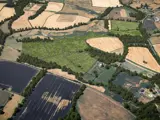Emberton Habitat Bank, Buckinghamshire
Local planning authority (LPA): Milton Keynes City Council
National Character Area (NCA): Bedfordshire and Cambridgeshire Claylands
Biodiversity Units available:
Very high distinctiveness habitats
- Lowland meadows
Medium distinctiveness habitats
- Mixed scrub
- Other neutral grassland
- Species-rich native hedgerow
The Emberton Habitat Bank is strategically located in proximity to existing ancient woodland and Local Wildlife Sites, providing fantastic ecological connectivity. This proximity, combined with the new habitats being created on-site, has the potential to attract species native to the area not currently present. This may include species such as nightingales, garden warblers, and turtle doves.
Following a thorough assessment of the site's existing habitats, wildlife, geology, hydrology, soil chemistry, management history, and landscape connectivity, we determined the best possible habitats to establish and made sure these enhancements would be deliverable. We established an ecological baseline for the site using Defra’s biodiversity metric, so we can clearly demonstrate biodiversity gains over time.
This assessment enables us to generate a range of high-integrity Biodiversity Units that will ensure robust ecological outcomes. We also offer planning support to make sure our Biodiversity Units provide an effective local BNG delivery solution for developers within the Milton Keynes City Council LPA area or Bedfordshire and Cambridgeshire Claylands NCA. Our Units are ready to purchase now, subject to availability.
Adjacent LPAs for cross-boundary coverage:
- Buckinghamshire Council
- Bedford Borough Council
- Central Bedfordshire Council
- West Northamptonshire Council
- North Northamptonshire Council
The Emberton Habitat Bank was established in 2022 and, over the course of the next three decades, we will convert degraded arable land into stunning fields of neutral grassland supporting a diverse array of species.
Across the southwestern corner of the site, we are establishing an area of lowland meadow, full of wildflowers to support pollinating insects. We are also planting a series of native hedgerows and a belt of woody scrub with open glades to increase the structural diversity across the site.
Over time we anticipate a dramatic increase in soil health and structure. This will help to rebuild local ecosystem services – improving the land’s water retention, sequestering carbon, and improving water and air quality.
With public footpaths located along the northern boundary, the local community will benefit from access to increased biodiversity close to their homes.
Find out the cost and availability of Biodiversity Units from our Milton Keynes Habitat Bank





